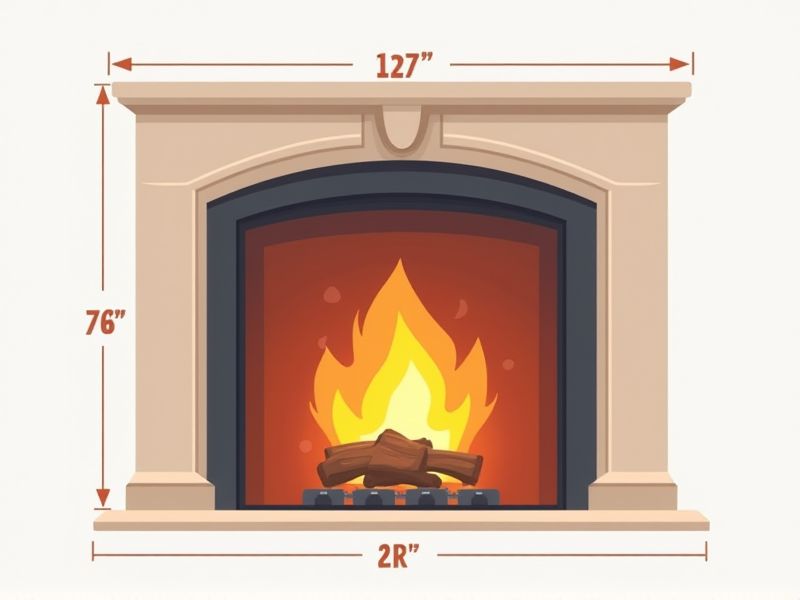
The standard dimensions of a fireplace can vary depending on the style and intended use, but most traditional wood-burning fireplaces have an opening width of 36 to 42 inches and a height of 28 to 32 inches. The firebox depth typically ranges from 16 to 20 inches, allowing for effective heat emission and safety. It's also important to consider the mantle height, which is commonly placed 54 to 60 inches above the floor to create a balanced look in the room. Always check your local building codes and consult a professional to ensure your fireplace meets safety and efficiency standards for your space.
Firebox Width
The standard firebox width for residential fireplaces typically ranges from 36 to 42 inches, allowing ample space for a visually appealing and functional fire. A wider firebox, such as those measuring 42 inches, can accommodate larger logs and produce a more substantial heat output, making it ideal for open-concept living spaces. Many fireplace designs also include a firebrick lining, which enhances heat retention and protects the structure from damage. When choosing your fireplace, consider the firebox width not only for aesthetics but also for efficiency and warmth distribution throughout your home.
Firebox Depth
The firebox depth in a fireplace is crucial, typically ranging from 16 to 20 inches for optimal performance. A deeper firebox ensures sufficient airflow and promotes efficient combustion, enhancing heat output. For safety and functionality, maintaining a depth aligned with your chosen fuel type is essential; gas fireplaces may require shallower designs compared to wood-burning models. Knowing the specifications allows you to tailor your fireplace to your specific heating needs and safety requirements.
Firebox Height
The ideal firebox height for standard fireplaces typically ranges between 18 to 24 inches, ensuring optimal heat distribution and safety. A firebox at this height allows for effective combustion while minimizing the risk of sparks escaping. Proper firebox dimensions also contribute to efficient airflow, enhancing the efficiency of fuel consumption. When selecting a fireplace, consider your specific space requirements and aesthetic preferences to achieve a harmonious balance between design and function.
Opening Width
The optimal opening width for a fireplace is typically between 36 and 42 inches, providing a balance between heat efficiency and aesthetic appeal. This width allows for a robust flame display while ensuring proper air circulation for combustion. A wider opening, exceeding 48 inches, may require additional design considerations to maintain safety and efficiency. When assessing your fireplace, consider how the opening width complements your living space and overall design theme.
Opening Height
The optimal opening height for a fireplace typically ranges from 36 to 42 inches, ensuring effective heat circulation while providing an aesthetically pleasing design. A taller opening height can enhance your view of the flames and contribute to a more dramatic ambiance in your living space. It is essential to consider the fireplace dimensions and the room's ceiling height when determining the perfect size for your installation. Properly configuring the opening height not only improves functionality but also adds to the overall safety and efficiency of your fireplace system.
Hearth Extension
Hearth extensions are crucial in fireplace design, as they enhance safety and efficiency. The minimum hearth extension for a traditional wood-burning fireplace is typically 16 inches in front and 8 inches on the sides, creating a protective barrier against heat and embers. For gas fireplaces, manufacturers often recommend a hearth extension of at least 12 inches. Ensuring compliance with local building codes is important, as these regulations can dictate the required dimensions and materials used in your fireplace installation.
Mantel Clearance
The standard mantel clearance for a fireplace typically requires a minimum distance of 12 inches above the opening to prevent heat damage and improve safety. This distance may vary based on the type of fireplace; for instance, gas fireplaces often require less clearance than traditional wood-burning models. Ensure that any combustible materials, such as decorations or furniture, are placed at least 36 inches away from the hearth to minimize fire risks. By following these guidelines, you can enhance the efficiency and safety of your fireplace while maintaining a visually appealing focal point in your living space.
Surround Width
The surround width of a fireplace significantly influences its aesthetic appeal and functionality, typically ranging from 4 to 8 inches. A wider surround, measuring closer to 8 inches, can create a more pronounced visual focal point, enhancing the room's overall design. You might find that a narrower surround, at around 4 inches, offers a minimalist look while still providing adequate clearance and safety. Consider how the surround width interacts with other elements in your space, as it plays a crucial role in harmonizing your interior decor.
Draft Area
The draft area of a fireplace is crucial for ensuring optimal combustion and heat efficiency. Ideally, the chimney height should be at least 3 feet above the roofline, with a minimum clearance of 2 feet over any nearby structure to promote effective airflow. A well-sized flue, typically ranging from 6 to 8 inches in diameter for residential units, aids in the proper venting of smoke and gases. Regular maintenance, including annual inspections and cleaning, can significantly improve draft performance and enhance safety in your home.
Chimney Flue Size
The chimney flue size is critical for ensuring efficient fireplace operation, typically requiring a minimum diameter of 6 inches for wood-burning units to facilitate proper draft and prevent smoke backup. A correctly sized flue can significantly reduce the risk of chimney fires, which data indicates can exceed 24,000 incidents annually in the United States alone. For optimal safety and performance, your fireplace should have a flue height that exceeds 3 feet above the roofline and a minimum clearance of 2 feet above any nearby structures. Correct sizing not only enhances combustion efficiency but also minimizes harmful emissions, making it essential for responsible fireplace use.
